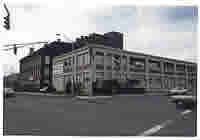Waste Site Cleanup & Reuse in New England
US EPA Brownfields Assessment Grant Paves the Way for New Business Growth
Success in EPA Brownfields Assessment Grant Program
New Britain, CT
(December 10, 2003)
Contacts
|
||||
NEW BRITAIN, CT- The abandoned Russell & Erwin factory in New Britain’s Technology Corridor was transformed following years of under-use and concerns of costly and potentially dangerous environmental contamination. A $200,000 EPA Brownfield Assessment Grant awarded to the city in September 1998 helped lift the stigma of environmental contamination. A successful business, Walgreens, now brings additional tax revenue and good corporate citizenship to the once contaminated site. Currently 40 residents are employed at the new Walgreens from the surrounding community. Walgreens, who has won various nationwide awards for good corporate citizenship, purchased the property in December, 2002, completed development in August 2003, and opened in September 2003.
Russell & Erwin, once New Britain’s largest hardware producer, built the 102 Washington Street site in 1887. The company later became the American Hardware Corporation in 1902 and the Emhart Company in 1964. The site maintained its hardware production roots until the Emhart Company shut down in the early 1970s. The factory site was later occupied by the State Department of Transportation for one year, a private realty company until 1979 and finally by Constructive Workshop, Inc., a non-profit training and employment facility. The city of New Britain bought the property in November 1993 following years of under-use and disrepair.
Original plans for the newly acquired building included creating a major high-rise office as part of the city’s ambitious Landmark Center Project. However, the Landmark Center lost financial momentum in the early 1990s and the site was offered for sale. By 1998, the site was still not sold due to concerns of environmental contamination that plagued the site. A fire destroyed a portion of the main building in 1999, leaving the original factory’s two-story addition that had been attached to the factory in 1929. No private business was willing to invest in the dilapidated site due to the rumored high cost of cleanup and huge potential liability costs.
The Phase I and Phase II assessments, which were funded with an $18,000 portion of the original EPA Brownfield Assessment grant, were performed by the TRC Environmental Corporation. The assessment confirmed that there were not significant levels of contamination at the site beyond large amounts of debris and ash, thus paving the way for the site’s redevelopment.
The community was involved in many aspects of the property cleanup. Community meetings were held that described the brownfields cleanup program and progress. A community-based Brownfields Awareness and Education Program was also created to help reduce fear associated with the redevelopment. The program highlighted the economic and community benefits of the property’s redevelopment.
The Russell & Erwin factory is just one of many small hardware parts manufacturers, which were once a staple of the town’s economy. A mass exodus of industry in the 70s and 80s, left the city with over 600,000 square feet of vacant and potentially contaminated land. As a result of this huge and growing problem, the city of New Britain has developed a brownfields cleanup initiative that encompasses six key properties which will be assessed and redeveloped with the help of the remaining monies from the original $200,000 EPA Assessment Grant. Sites that have already achieved an environmental and economic renaissance include: the former Sandelli Greenhouses that were transformed into the Urban Oaks Organic Farm and the former Howard Cleaners that has been remediated and is now ready for private purchase. The City received an additional $60,000 EPA Brownfields Cleanup Grant in 2003 to begin cleanup at 207 Oak Street that once housed a gas station and auto repair shop.
With the help of the USEPA and the addition of new and successful businesses to the area, the city of New Britain is finally taking back some of hundreds of acres of abandoned, unused, and potentially contaminated factories, giving city dwellers back a piece of their once burgeoning New England community.
The city of New Britain, has a population of approximately 75,000 people, with a population density of 5,000 people living in each square mile of the city, as compared to state’s average 700 people per square mile. The city boasts a large minority population with 27% of the population of Hispanic or Latino descent (22% of which are of Puerto Rican ancestry). Another 11% of the population is of African American descent. The median household income is just over $34,000 dollars a year, as compared to almost $54,000 for the state according to the 1999 US Census.

